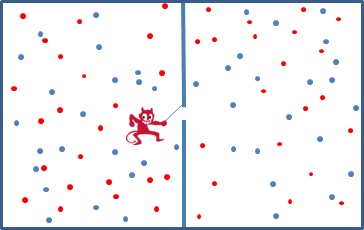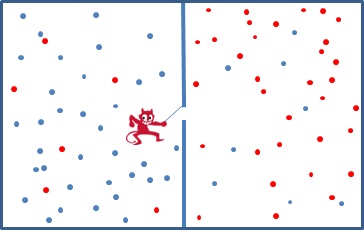 |
Maxwell's Demon | Maxwell Legacy Concepts |
|---|
In a nutshell |
Maxwell's demon is a concept Maxwell made public in the 1870s that could apparently defeat the second law of thermodynamics. A law defeated is no law and so the demon concept appeared to cast doubt on a fundamental understanding of physics that was a powerful idea. The demon (Maxwell called it just an 'agent'; William Thomson named it a 'demon') operated a trap door between an isolated box of gas divided by a partition, spying the fast moving molecules and letting them through into one side but retaining the slow moving ones. He could also do the reverse. After a while, for example, half of the gas becomes hotter and half colder, with no expenditure of energy. Indeed work could now be done restoring the thermal equilibrium so amongst other implications, unlimited energy could be extracted simply by having such a demon. |
 |
|---|
| Technical detail | The first law of thermodynamics is essentially a statement about the conservation of energy. The second law says in effect that there may be many processes that will conserve energy but the only ones that in fact will happen are those processes that increase the disorder of the system. The concept of 'disorder' is embedded in the concept of entropy. The second law is more precisely worded by saying that the changes taking place in an isolated system will increase its entropy or at best leave it unchanged. If a process leaves entropy unchanged it is said to be 'reversible'; otherwise it is 'irreversible'. In reality, reversible changes are mainly confined to textbooks. There is no conceptual problem in decreasing the entropy in one part of a larger system, creating some local order, but the second law says that the entropy of the whole isolated system will increase. In the adjacent figures, the demon has changed a highly disordered system inside the supposedly isolated box in which the energetic (red) molecules and less energetic (blue) molecules are dotted around at random (top figure) to the much more ordered system with more of the energetic molecules on one side and the less energetic mainly on the other (bottom figure). The second arrangement has lower entropy, therefore confounding the second law. For a century of so after Maxwell introduced his demon, various efforts were made to consider possible realisations of the demon's actions by real apparatus. Some ingenious suggestions have been made but each one has been shown to be flawed. We can confidently say that Maxwell's demon is an imaginary concept. Even without the demon, it's quite possible by chance that more hot molecules will pass through the hole in one direction than the other in a short space of time, thereby slightly decreasing the entropy of the system. The second law is therefore only statistically true over time and when the system has a large number of possible states. Maxwell and his contemporaries were aware of this. The second law was part of a concerted 19th century effort to understand the relationship bewteen heat and work. It is, though, the driving concept behind the entire evolution of the universe. It is because of the second law that time goes only one way, why the past is intrinsically different from the future. At the origin of the universe we know, 13.8 billion years ago, the universe had a very low entropy. Ever since, the entropy of the universe has been increasing. It is a one-way trip. On long timescales and in the wide view, there is no such thing as the 'balance of nature'. Creation, evolution, life and death is the result. There are no real demons to break this sequence. Reference: Maxwell's own personal involvement with his demon and contemporary reactions are discussed in Elizabeth Garber, Stephen G. Brush & C. W. F. Everitt "Maxwell on Heat and Statistical Mechanics", Associated University Presses, London, 1995. JSR 2016 |
 |
|---|